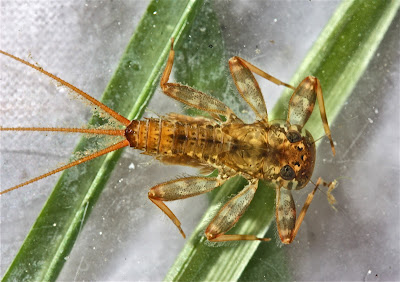It's great to see the stoneflies returning: the small winter stoneflies, large winter stoneflies, Perlodid stoneflies (Clioperla and Helopicus), and now Chloroperlids -- green stoneflies.
This morning I went back to the upper Doyles River, where Rt. 810 makes a sharp turn to the right passing over the stream. When I was here on October 10th -- you might recall -- I found that magnificent flatheaded mayfly, Maccaffertium vicarium. I was hoping I might see more today: I didn't, but I was not disappointed.
The leaf packs were overflowing with small winter stoneflies -- at the moment this is clearly the dominant taxon I'm finding in all of the streams that I visit. But, I did find my first Chloroperlid of the new season.
It was small, and when they're this small it's not always easy to tell them apart from the small winter stones with a quick glance. But a trained eye can pick out a couple of things. Let's look at a small winter that I found today and note how they visibly differ.
First of all notice the length of the tails. The short pointed tails on the green stoneflies provide us with a pretty good clue about what we're seeing. Also, note that the abdomens are not shaped the same -- the Chloroperlid abdomen is neither as long nor as thin as that of the small winter stonefly, and it's wider in the middle than it is at the ends -- and the heads are not shaped the same. You can see some of those things in one photo I got where the two nymphs were floating next to each other.
Also, the wing pads look nothing alike: the front and back wing pads of the green stonefly look much the same (though they're not well developed on this very young nymph). A microscope view of the two side-by-side.
But for certain ID, it's not safe to go by appearance alone. For one thing, as we see in the photo above, the distinctive short tails on the green stonefly sometimes break off! To safely ID our Chloroperlid, we have to look at the labium -- the underside of the head.
When we see the position of the glossae (g) and paraglossae (p), and the "notch" that forms between them, we know right away that this is no small winter stonefly, it's either Perlodid or Chloroperlid. (Perlids have the same "notch," but this cannot be a Perlid since there are no gills between the legs.)
To decide between Perlodid and Chloroperlid -- we have to look at the tips of the maxillary palps. Note the contrast in size between the terminal palpal segments on our little nymph and the next segment down. That contrast makes this Chloroperlid: with Perlodids, the distinction between those two segments is not nearly so marked.
So, our first Chloroperlid of the new season, probably genus Sweltsa -- but it's really too early to tell.
I found a lot of insects today at the Doyles, and "diversity" is the key word to use. For stoneflies: there were Perlids (common stoneflies), two different species -- Acroneuria abnormis and Acroneuria carolinensis; one Perlodid -- probably Clioperla, but I forgot to keep it and check; two Giant stoneflies; lots and lots of small winter stoneflies (Capniidae); and, of course, the one Chloroperlid. That's five families and two different species of Perlid genus Acroneuria. Mayflies: I found lots of flatheaded mayflies, all Maccaffertium by genus, but I'm sure there was more than one species; and I found several pronggilled mayflies (genus Paraleptophlebia); and I found the usual -- or so it seems -- one small minnow mayfly, Acentrella turbida, our "fall" small minnow species. I also saw a few black flies, a few crane flies, some fingernet caddis, one common netspinner caddis, and four freeliving caddisfly larvae, some little some big.
I'll show some nice photos of some of these bugs in a moment, but there is a point that needs to be made. Diversity. This is a stream with a diverse assortment of insects, and "diversity" -- in family, genus and species -- is one of the marks of a good, healthy stream. Why? Because the types of habitat exist that will support a thriving ecological community. Everyone finds something to eat. True, some of the insects eat one another. But, the dissolved oxygen levels, the leaf packs, the algae, riffles and rocks and substrate, make it possible for tolerant and intolerant insects to live together and thrive, to find shelter and food.
Now for some photos:
1. Common stonefly, Acroneuria carolinensis: one of the few places I've found this particular species.
2. A beautiful flatheaded mayfly, genus Maccaffertium -- I don't know the species. However, it is not M. vicarium.The ventral side of the abdomen looks nothing like what we would see on that species (see the entry on 10/10.)
3. A pronggilled mayfly, with another good look at the "tuning fork" gills.
4. Two freeliving caddisflies (Rhyacophilidae), one little one big. Note how the greens have darkened on the more mature nymph.
5. Our requisite small minnow mayfly, Acentrella turbida. Note the broad thorax.
6. And last but not least, a Giant stonefly with a flatheaded mayfly hitching a ride!
______
Below: a small winter stonefly -- very pretty, but the ends of the tails have broken off.



















No comments:
Post a Comment